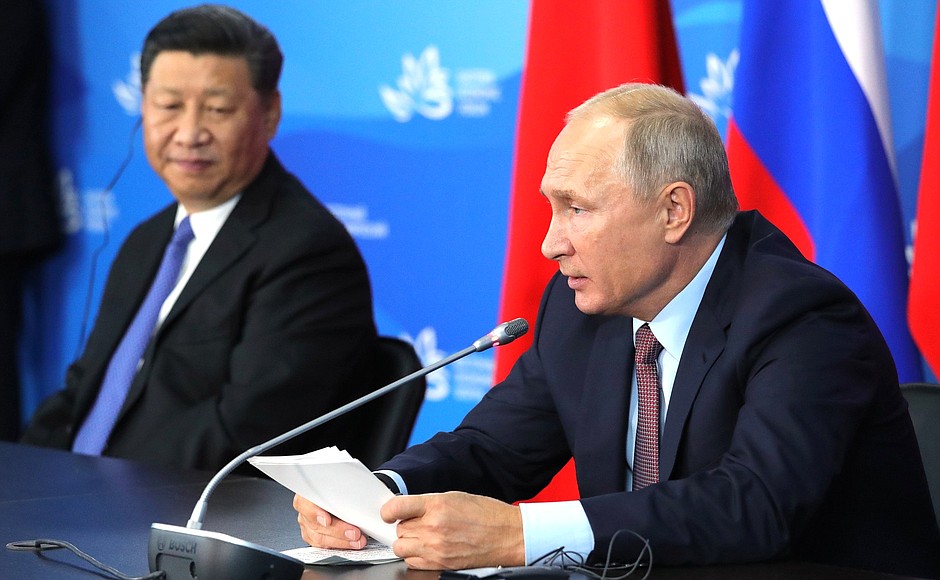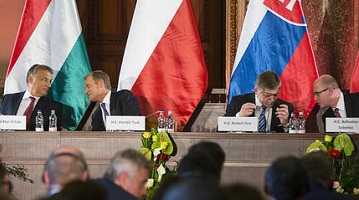I was kindly asked by Tom O’Connor from Newsweek to provide him with my answers to six questions considering the relationship between China and Russia, which I gladly did as I have been extensively dealing with these issues since several years now. I would also like to point to the Around the World in 8 (or so) Pages Outlook by Sune Sorensen from April 2019, which contains part of my research on this topic as well. Furthermore, an academic paper on the Dragonbear will be published by the end of the year.
1). How would you describe the relationship between China and Russia? Some say strategic alliance; some say marriage of convenience… What would you call it and how did you coin the term Dragonbear?
As I was identifying key trend developments considering the Global System and the future global powers competition back in 2015, I coined the term of the Dragonbear to describe the probability of an emergence of a highest-ranking systemic relationship and comprehensive rapprochement between China and Russia in various key fields. The Dragonbear is neither an alliance nor a marriage of convenience, but rather a temporary asymmetric relationship, in which China is predominantly the agenda-maker, while Russia is mostly the agenda-taker. So long as the Dragonbear shares the common interest in opposing the US in every possible field, the systemic coordination of actions and measures between China and Russia will continue despite emerging bottom-up tensions in areas of intersection of their national interests.
The main common denominator of the Dragonbear isn’t just the goal of opposing the USA, but also establishing and consolidating a Eurasian land connectivity as a response to the American maritime dominance in the Indo-Pacific realm, and thus making sure that there is a certain independence from maritime chains of supply in case of future blockades. This is very much oriented against US and European interests as Moscow and Beijing share a common objective of excluding third actors’ involvement in Eurasia.
2). At what point do you feel the Chinese and Russian relationship shifted from competition to “friendship”? Have they overcome their historical hostilities?
China and Russia are natural rivals; thus, they deliberately avoid addressing issues that contain certain historical hostilities or might unleash serious tensions in their bilateral relations. Their relationship shifted towards comprehensive coordination in various fields following the isolation of Russia in the West (Georgia war 2008, Ukraine war 2014) as well as the newly emerging competition between the USA and China.
China and Russia have settled their longstanding territorial disputes and have demarcated their common border. Thus, no territorial claims or border disputes are expected to damage their bilateral relations. Although both countries are involved in territorial conflicts with third countries, they do not seek to interfere or mutually influence their positions or approaches (for instance, Russia’s role in the frozen conflicts and China’s role in the South China Sea are not colliding).
Potential friction between Russia and China lies in the geographic prioritization and the overlapping geopolitical interests. Russia is a regional power possessing nuclear weapons with global reach and with vertical expansion of geopolitical and geo-economic interests from the Arctic and the Baltics through the Eurasian landmass and its neighbourhood in Eastern Europe to the Caspian, Black and Mediterranean Seas as well as to the Balkans and the MENA region. However, there is a well-established Russian fear of Chinese penetration particularly in Central Asia and the Far East as well as other traditional spheres of influence such as the Balkans, Eastern Europe and the rest of the former Soviet space. Furthermore, Africa and to some extent Latin America may become a playground of conflictual tactics (e.g. Venezuela, Sudan etc.). Moreover, their interests in the energy sector do not overlap since Russia is one of the major oil suppliers while China tops the list of the countries with greatest oil imports. A sort of new energy interdependence as the one between Russia and Europe could emerge in the short and mid-term as Russia is increasingly taking the role of supplying China with oil and natural gas through various pipelines and thus diversifying its energy portfolio away from Europe.
3). Many analysts characterize Russia as the junior partner in this partnership, others say it’s symbiotic in that Moscow brings the muscle and Beijing brings the money, how would you address the dynamics?
I would describe the current dynamics as being indicative of an asymmetric relationship, in which China provides the liquidity and Russia provides the natural resources and the necessary know-how in key fields such as diplomacy, defence, space, etc.
Furthermore, a new connectivity is being explored and expanded such as in the Arctic, Central Asia and beyond to balance the US-dominated global supply chains. However, the current Chinese grand projects constitute a horizontal expansion from China to Europe and Africa through a network of various connectivity and infrastructure tools (transport routes, pipelines, trade roads, loans programs etc.) and are meanwhile institutionally backed by a set of China-led organisations such as the Asian Infrastructure Investment Bank, the Eurasian Investment Bank, the Shanghai Cooperation Organization etc.
Meanwhile, it’s about communication and coordination of measures in the fields of energy, agricultural trade, military and the defence industry, international organizations as well as transit corridors via Russia to Europe.
4). To what extent does pushing back against what both Russia and China have described as a US-led world order and motivation for a multipolar scene motivate their relationship? Can they succeed in challenging Washington’s global hegemony?
The global power competition is clearly an outcome of the emerging Global System transformation causing major reshuffles of the globalized networks and structures of finance and monetary systems, global trade and economy as well as energy, agriculture, water and food systems amid the Fourth Industrial Revolution.
Against this background, the process of polarization and partition is imminent and will be further deepened by the emerging systemic rivalry between China and US, while all significant regional players and free riders (including Russia) will have to take an ‘either/or’ decision and position themselves in between at some point.
Russia has been seizing the opportunity to build a strategic coordination with China due to its isolation in the West since the war in Ukraine, capitalizing on the fact that neither the US nor China wants Russia to be part of the adversary’s bloc. From Beijing’s perspective, the worst-case scenario of the bilateral relations with Russia would be a situation in which Russia starts adapting to the rise of China by balancing through a potential ad hoc partnership with the USA, just like China did in the 1970s during the Cold War. Obviously, Moscow would not tolerate an emergence of Pax Sinica in continental Eurasia and the neighbouring areas that have been Russian strongholds for centuries.
The Dragonbear is about counterbalancing arising centrifugal forces in all fields — from the global economy, finance and trade, to diplomacy and political links, to military, defence and strategic alliances. But it also has a lot to do with the countries’ overlapping understanding that the world is in a system transformation, whose results are unpredictable and whose implications might be very dangerous for them. Trump will clearly seek to break the Dragonbear by playing out China and Russia against each other and by coming closer to Russia, which is why the Helsinki summit format is important to him in the first place. What is the common denominator for Trump and Putin? Trump will seek to divide the EU and the NATO institutions because he is not interested in blocs, but rather in bilateral agreements, partnerships and alliances with single EU and NATO members, which are loyal to the American interests and comply with Trump’s agenda.
5) Do you foresee this relationship blossoming in the near future? Will economic agreements match their military cooperation? Could there ever be a defensive alliance between these two powers, are they doomed to compete or is the status quo acceptable on both ends?
The relationship is evolving into a highest-ranking (top-down) coordination between President Putin and his closest circle, on the one side, and President Xi Jinping and his closest supporters, on the other side, which makes sure that the Dragonbear gets further consolidated despite existent bottom-up tensions on the ground (e.g. in Kazakhstan there are already fears of an overwhelming Chinese presence in all spheres through loans, investments and business activities, whereas the political elite is still very much influenced by Russia). Both countries still struggle to diversify their economic and trade portfolio by identifying potential areas and directly arranging deals at the top level, however, neither the trade volume nor the economic ties have extensively been expanded despite these efforts (the trend is however positive).
China has interests in a defence cooperation with Russia due to Russia’s possible transfer of advanced technologies and sophisticated weapons. Possible military cooperation is also a basis for the strategic bilateral ties. Joint military exercises and first joint air patrol have become a substantial part of it with the aim of facilitating better interoperability between the armed forces. So far, Russia and China have conducted joint naval drills in the Mediterranean Sea and the Sea of Japan. The mutual defence cooperation also evolves within the SCO, whose role as an emerging regional organization is growing after India and Pakistan have joined it.
Russia still needs a powerful ally due to its isolation in the West, whereas China seeks a dependable junior partner to increase its international clout. However, this relationship will deepen but not necessarily solely blossom depending on how successful/unsuccessful China’s rise will be. A strong element of posturing should be taken into account as it is in both countries’ interest to create an impression of a stable and resistant alliance against the West, particularly to restrain the American actions against them. Currently, there are negotiations on a defence cooperation deal between Moscow and Bejing, however, there are no clear signals towards a defensive alliance between these two powers. It seems that the rapprochement has a tactical rather than a strategic nature, following the maxim “Keep your friends close and your enemies closer”. A status quo relationship would remain acceptable and be further developed so long as China’s rise is not a direct threat to Russia’s strategic interests of self-determination and security along its peripheries.
6). Europe is in a difficult spot, facing internal crises and a US that doesn’t necessarily share the same values. Do you see the Belt and Road Initiative and Eurasian Economic Union developing into an enticing alternative? Can the US undermine this and how?
Eventually, Europe woke up to the realities of an emerging bipolar structure of the Global System with the USA and China being the antipodes in the new scenario. The EU even declared China as a ‘systemic rival’, however Brussels and its member states will simultaneously have to deal with a much more assertive China, now that it has become a European power, as well as a much more assertive US. President Trump wants to address the trade imbalances as well as their free riding position due to the symbiosis of US defence spending and European social programs over the last decades. Russia, on its part, will not have the economic potential to play a key role regarding global economy and trade. However, Moscow will remain one of the major powers in terms of nuclear and conventional weapons as well as in space and military technologies. Hence, Russia will play a role in global affairs, but it will shape them through forcing the Eurasian regional integration at any price and forming strategic alliances.
The EU is clearly challenged to respond adequately to the emergence of these two current system poles (the USA and China) for both ideological and security reasons. Furthermore, these developments might endanger the EU project by creating new dividing lines among the EU members along American and Russian interests in the Old Continent. In this sense, the EU and its members must put European interests first in order to navigate through the complex triangular relations between the USA, China and Russia in the emerging bipolar world order.
The EU with its member states are pushed away or squeezed out from global and regional markets; the global GDP share; trade and economic partnerships; global supply chains, international and regional organisations, negotiation forums and formats.
Europe should not take sides amid the growing systemic rivalry between the USA and China, nor should the EU and its member states seek to take ‘either/or’ decisions during this rivalry. Thus, the EU and the member states should pursue a unique European way of navigating through an increasingly systemic bipolarity with multiple regional hotspots and emerging polarization between two specific power centres — the USA and China, with regional actors such as the EU and member states, Japan, India, etc. trying to keep the balance between them.
So far, there has been an agreement between China and Russia to merge the BRI and EEU in Central Asia in order to prevent third actors from entering the region or expanding their clout there as well as to accommodate Sino-Russian relations in the region. However, the symbiotic relationship between BRI and EEU has remained predominantly rhetorical, and with a symbolic significance for bilateral relations.






